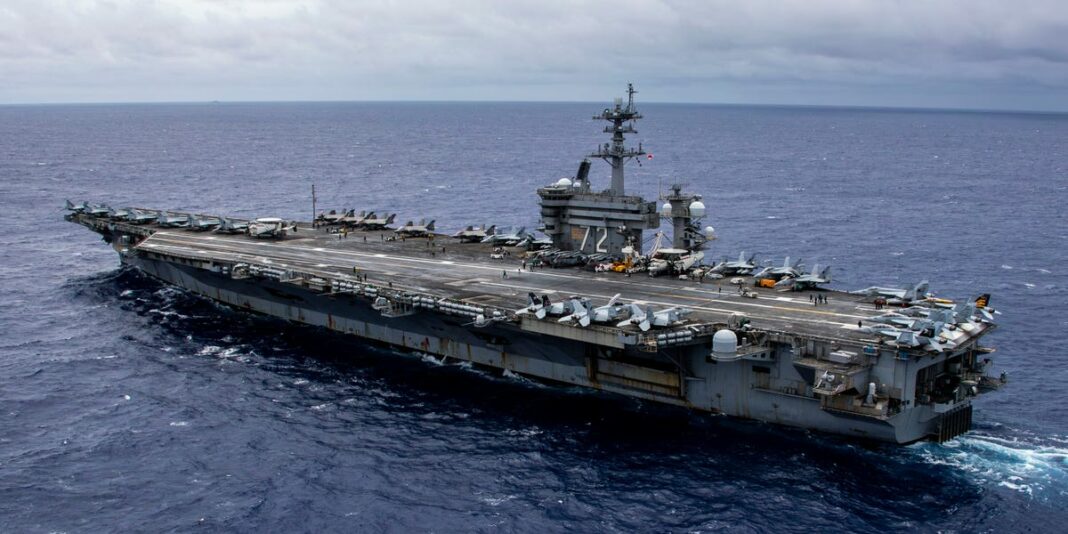The US naval presence around the Middle East is getting a firepower boost
As tensions continue to rise in the Middle East, the United States is increasing its naval presence in the region. This comes as a response to the heightened threats posed by Iran and other hostile actors in the area. The US Navy has already deployed several warships to the region, with more on the way to ensure the safety and security of vital shipping lanes and to deter any potential aggression. Let’s take a look at the warships that are currently stationed in the Middle East and what additional firepower is on its way.
Warships in the Middle East
Currently, the US Navy has a number of warships stationed in the Middle East to protect American interests and ensure regional stability. Some of the key vessels in the area include:
USS Abraham Lincoln (CVN-72)
The USS Abraham Lincoln is a Nimitz-class aircraft carrier that is currently deployed to the Middle East. With its complement of fighter jets and support aircraft, the Lincoln provides a crucial air presence in the region and serves as a deterrent to any potential threats.
USS Cole (DDG-67)
The USS Cole is an Arleigh Burke-class destroyer that is also stationed in the Middle East. Equipped with advanced missile systems and anti-aircraft capabilities, the Cole plays a key role in protecting US and allied ships from potential attacks.
USS Lewis B. Puller (ESB-3)
The USS Lewis B. Puller is a expeditionary mobile base ship that is currently operating in the Middle East. With its ability to support a variety of missions, including special operations and logistics support, the Puller provides a versatile platform for US forces in the region.
Upcoming Deployments
In addition to the warships already stationed in the Middle East, the US Navy is also expected to deploy additional firepower to the region in the near future. Some of the vessels that are slated to join the existing fleet include:
USS Theodore Roosevelt (CVN-71)
The USS Theodore Roosevelt is a Nimitz-class aircraft carrier that is set to deploy to the Middle East in the coming months. With its powerful air wing and strike capability, the Roosevelt will significantly enhance the US Navy’s presence in the region and provide an additional layer of deterrence against potential threats.
USS Paul Ignatius (DDG-117)
The USS Paul Ignatius is an Arleigh Burke-class destroyer that is also expected to join the fleet in the Middle East. With its advanced radar and missile systems, the Ignatius will bolster the defensive capabilities of US forces in the region and help ensure the safety of vital shipping lanes.
Conclusion
The US naval presence in the Middle East is undergoing a significant firepower boost in response to escalating tensions in the region. With a combination of existing warships and upcoming deployments, the US Navy is well-equipped to protect American interests, ensure regional stability, and deter any potential threats. By maintaining a strong presence in the Middle East, the US Navy plays a crucial role in promoting security and safeguarding vital maritime routes.
FAQs
Q: Why is the US increasing its naval presence in the Middle East?
A: The US is increasing its naval presence in response to heightened threats in the region, particularly from Iran and other hostile actors. By bolstering its forces in the Middle East, the US aims to protect American interests, ensure regional stability, and deter potential aggression.
Q: What role do aircraft carriers play in the US Navy’s operations in the Middle East?
A: Aircraft carriers serve as key platforms for projecting power and conducting air operations in the region. With their complement of fighter jets and support aircraft, carriers like the USS Abraham Lincoln and USS Theodore Roosevelt provide a vital air presence and serve as a deterrent to potential threats.
Q: How does the US Navy contribute to maritime security in the Middle East?
A: The US Navy plays a critical role in maintaining maritime security in the Middle East by patrolling vital shipping lanes, conducting anti-piracy operations, and deterring hostile actions. Through its presence in the region, the US Navy helps safeguard international trade and ensure the free flow of goods and resources.




